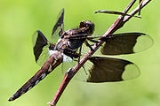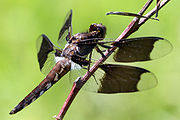
Common Whitetail
Encyclopedia
The Common Whitetail or Long-tailed Skimmer (Libellula lydia) is a common dragonfly
across much of North America
, with a striking and unusual appearance. The male's chunky white body (about 5 cm long), combined with the brownish-black bands on its otherwise translucent wings, give it a checkered look. Females have a brown body and a different pattern of wing spots, closely resembling that of female Libellula pulchella, the Twelve-spotted Skimmer. Whitetail females can be distinguished by their smaller size, shorter bodies, and white zigzag abdominal stripes; the abdominal stripes of L. puchella are straight and yellow.
 The Common Whitetail can be seen hawking for mosquito
The Common Whitetail can be seen hawking for mosquito
es and other small flying insects over ponds, marshes, and slow-moving rivers in most regions except the higher mountain regions. Periods of activity vary between regions; for example in California
, the adults are active from April to September.
Like all perchers
, Common Whitetails often rest on objects near the water, and sometimes on the ground. Males are territorial, holding a 10 to 30 metre stretch of the water's edge, and patrolling it to drive off other males. The white pruinescence
on the abdomen
, found only in mature males, is displayed to other males as a territorial threat.
The nymphs are dark green or brown, but are usually found covered in algae. They feed on aquatic invertebrates such as mayfly
larvae and small crayfish
, and also on small aquatic vertebrates such as tadpole
s and minnow
s. Because of their abundance, whitetail naiads are in turn an important food source for various fish, frogs, and birds, and also for other aquatic insects.
Some authorities classify the whitetails, including the Common Whitetail, in genus
Plathemis rather than Libellula. This matter has been debated at least since the end of the nineteenth century. Recent molecular systematics evidence suggests that separation of the whitetails from the rest of Libellula may be appropriate.
Dragonfly
A dragonfly is a winged insect belonging to the order Odonata, the suborder Epiprocta or, in the strict sense, the infraorder Anisoptera . It is characterized by large multifaceted eyes, two pairs of strong transparent wings, and an elongated body...
across much of North America
North America
North America is a continent wholly within the Northern Hemisphere and almost wholly within the Western Hemisphere. It is also considered a northern subcontinent of the Americas...
, with a striking and unusual appearance. The male's chunky white body (about 5 cm long), combined with the brownish-black bands on its otherwise translucent wings, give it a checkered look. Females have a brown body and a different pattern of wing spots, closely resembling that of female Libellula pulchella, the Twelve-spotted Skimmer. Whitetail females can be distinguished by their smaller size, shorter bodies, and white zigzag abdominal stripes; the abdominal stripes of L. puchella are straight and yellow.

Mosquito
Mosquitoes are members of a family of nematocerid flies: the Culicidae . The word Mosquito is from the Spanish and Portuguese for little fly...
es and other small flying insects over ponds, marshes, and slow-moving rivers in most regions except the higher mountain regions. Periods of activity vary between regions; for example in California
California
California is a state located on the West Coast of the United States. It is by far the most populous U.S. state, and the third-largest by land area...
, the adults are active from April to September.
Like all perchers
Libellulidae
The skimmers or perchers and their relatives form the Libellulidae, the largest dragonfly family in the world. It is sometimes considered to contain the Corduliidae as the subfamily Corduliinae and the Macromiidae as the subfamily Macromiinae. Even if these are excluded , there still remains a...
, Common Whitetails often rest on objects near the water, and sometimes on the ground. Males are territorial, holding a 10 to 30 metre stretch of the water's edge, and patrolling it to drive off other males. The white pruinescence
Pruinescence
Pruinescence, or pruinosity, is a "bloom" caused by pigment on top of an insect's cuticle that covers up the underlying coloration, giving a dusty or frosted appearance. The pruinescence is commonly white to pale blue in color, but can also be gray, pink, purple, or red; these colors may be...
on the abdomen
Abdomen
In vertebrates such as mammals the abdomen constitutes the part of the body between the thorax and pelvis. The region enclosed by the abdomen is termed the abdominal cavity...
, found only in mature males, is displayed to other males as a territorial threat.
The nymphs are dark green or brown, but are usually found covered in algae. They feed on aquatic invertebrates such as mayfly
Mayfly
Mayflies are insects which belong to the Order Ephemeroptera . They have been placed into an ancient group of insects termed the Palaeoptera, which also contains dragonflies and damselflies...
larvae and small crayfish
Crayfish
Crayfish, crawfish, or crawdads – members of the superfamilies Astacoidea and Parastacoidea – are freshwater crustaceans resembling small lobsters, to which they are related...
, and also on small aquatic vertebrates such as tadpole
Tadpole
A tadpole or polliwog is the wholly aquatic larval stage in the life cycle of an amphibian, particularly that of a frog or toad.- Appellation :...
s and minnow
Leuciscinae
Leuciscinae, commonly known as true minnows, are a subfamily of small fish belonging to the family Cyprinidae.However, the term minnow is also used as an unspecific term for tiny freshwater and saltwater fish, especially those used as fishing bait....
s. Because of their abundance, whitetail naiads are in turn an important food source for various fish, frogs, and birds, and also for other aquatic insects.
Some authorities classify the whitetails, including the Common Whitetail, in genus
Genus
In biology, a genus is a low-level taxonomic rank used in the biological classification of living and fossil organisms, which is an example of definition by genus and differentia...
Plathemis rather than Libellula. This matter has been debated at least since the end of the nineteenth century. Recent molecular systematics evidence suggests that separation of the whitetails from the rest of Libellula may be appropriate.

